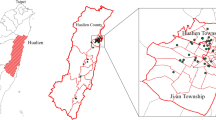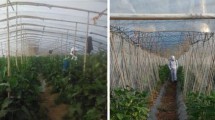Abstract
Purpose
To assess occupational inhalation exposure to the herbicide atrazine during pesticide application in a developing country.
Methods
Personal air samples were collected during atrazine application using a personal sampling pump equipped with an OSHA Versatile Sampler (OVS-2) sorbent tube. Samples were collected from 24 pesticide applicators in Honduras. Application was observed during sampling, and a survey was completed in the home.
Results
Fourteen of the 24 participants used pump backpack sprayers to apply atrazine and 10 used tractor/boom systems. Despite applying about 15 times as much atrazine, the tractor/boom participants (11.5 μg/m3) had only slightly higher (not statistically significant) time-weighted averages (TWA) than participants using backpack sprayers (9.6 μg/m3). Within the backpack sprayer group, those that used a cone spray nozzle (11.54 μg/m3) had nearly double the TWA than applicators using a flat spray nozzle (5.98 μg/m3; P = 0.04). In the tractor/boom group, the participants that rode on the boom or the back of the tractor monitoring nozzles (15.0 μg/m3) had almost double the average TWA than tractor drivers (8.0 μg/m3; P = 0.097).
Conclusions
Since tractor/boom pesticide application decreases the number of man-hours required to apply pesticides, and does not increase inhalation exposure significantly, it decreases the overall population occupational exposure. Monitoring nozzles on booms from a distance rather than on the back of a tractor or boom may decrease or eliminate inhalation exposure. Use of flat spray nozzles for herbicide application among pump backpack sprayers may reduce their inhalation exposure.





Similar content being viewed by others
References
ACGIH (2001) Threshold limit values of chemical substances. ACGIH, Cincinnati, OH
Ademola JI, Sedik LE, Wester RC, Maibach HI (1993) In vitro percutaneous absorption and metabolism in man of 2-chloro-4-ethylamino-6-isopropylamine-s-triazine (Atrazine). Arch Toxicol 67:85–91
Aragón A, Aragón C, Thörn Å (2001) Pests, peasants, and pesticides on the northern Nicaraguan pacific plain. Int J Occup Environ Health 7:295–302
Aragón A, Blanco LE, Funez A, Ruepert C, Lidén C, Nise G, Wesseling C (2006) Assessment of dermal pesticide exposure with fluorescent tracer: a modification of a visual scoring system for developing countries. Ann Occup Hyg 50:75–83
Arbuckle TE, Lin Z, Mery LS (2001) An exploratory analysis of the effect of pesticide exposure on the risk of spontaneous abortion in an Ontario farm population. Environ Health Perspect 109(8):851–857
Baharuddin MR, Sahid IB, Noor MA, Salaiman N, Othman F (2011) Pesticide risk assessment: a study on inhalation and dermal exposure to 2,4-D and paraquat among Malaysian paddy farmers. J Environ Sci Health B 46(7):600–607
Clarke EE, Levy LS, Spurgeon A, Calvert IA (1997) The problems associated with pesticide use by irrigation workers in Ghana. Occup Med 47:301–308
Cooper RL, Stoker TE, Tyrey L, Goldman JM, McElroy WK (2000) Atrazine disrupts the hypothalamic control of pituitary-ovarian function. Toxicol Sci 53(2):297–307
Donna A, Crosignani P, Robutti F, Betta PG, Bocca R, Mariani N, Ferrario F, Fissi R, Berrino F (1989) Triazine herbicides and ovarian epithelial neoplasms. Scand J Work Environ Health 15:47–53
Dowling KC, LE Blanco R, Martínez MI, Aragón BA, Bernard CE, Krieger RI (2005) Urinary 3,5,6-trichloro-2-pyridinol levels of chlorpyrifos in Nicaraguan applicators and small farm families. Bull Environ Contam Toxicol 74:380–387
Galvao LA, Escamilla JA, Henao S, Loyola E, Castillo SC, Arbelaez P (2002) Pesticides and health in the Central American isthmus. Pan American Health Organization, Washington, DC. Retrieved from http://www.paho.org/English/AD/SDE/RA/RA_Pesticides.pdf
Hayes T, Haston K, Tsui M, Hoang A, Haeffele C, Vonk A (2003) Atrazine-induced hermaphroditism at 0.1 ppb in American leopard frogs (Rana pipiens): laboratory and field evidence. Environ Health Perspect 111(4):568–575
Henao S, Arbelaez MP (2002) Epidemiological situation of acute pesticide poisoning in Central America, 1992–2000. Epidemiol Bull/PAHO 23(3):5–9
Ikonen R, Kangas J, Savolainen H (1988) Urinary atrazine metabolites as indicators for rat and human exposure to atrazine. Toxicol Lett 44:109–112
Keifer M, Rivas F, Moon JD, Checkoway H (1996) Symptoms and cholinesterase activity among rural residents living near cotton fields in Nicaragua. Occup Environ Med 53:726–729
Kniewald J, Jakominic M, Tomljenovic A, Simic B, Romac P, Vranesic D, Kniewald Z (2000) Disorders of male rat reproductive tract under the influence of atrazine. J Appl Toxicol 20(1):61–68
Libich S, To JC, Frank R, Sirons GJ (1984) Occupational exposure of herbicide applicators to herbicides used along electric power transmission line right-of-way. AIHAJ 45:56–62
Lozier MJ, Curwin BD, Nishioka MG, Sanderson WT (2011) Determinants of atrazine contamination in the homes of commercial pesticide applicators across time. J Occup Environ Hyg 9(5):289–297
Mattix KD, Winchester PD, Scherer LR (2007) Incidence of abdominal wall defects is related to surface water atrazine and nitrate levels. J Pediatr Surg 42(6):947–949
Mills PK (1998) Correlation analysis of pesticide use data and cancer incidence rates in California counties. Arch Environ Health 53(6):410–413
OSHA Salt Lake City Technical Center (2005) In-house file. June 14th, 2005, Salt Lake City, Utah. Retrieved from https://www.osha.gov/dts/chemicalsampling/data/CH_219760.html
Rodriguez VM, Thiruchelvam M, Cory-Slechta DA (2005) Sustained exposure to the widely used herbicide atrazine: altered function and loss of neurons in brain monoamine systems. Environ Health Perspect 113(6):708–715
Rodríguez T, Younglove L, Lu C, Funez A, Weppner S, Barr DB, Fenske RA (2006) Biological monitoring of pesticide exposures among applicators and their children in Nicaragua. Int J Occup Environ Health 12:312–320
Savitz DA, Arbuckle T, Kaczor D, Curtis KM (1997) Male pesticide exposure and pregnancy outcome. Am J Epidemiol 146(12):1025–1036
Spiller HA, Gallenstein GL, Murphy MJ (2003) Dermal absorption of a liquid diphacinone rodenticide causing coagulaopathy. Vet Hum Toxicol 45(6):313–314
Steinberg KK, Garza A, Bueso JA, Burse VW, Phillips DL (1989) Serum pesticide concentrations in farming cooperatives in Honduras. Bull Environ Contam Toxicol 42:643–650
van Wendel de Joode BN, de Graaf IAM, Wesseling C, Kromhout H (1996) Paraquat exposure of knapsack applicators on banana plantations in Costa Rica. Int J Occup Environ Health 2:294–304
Weisenburger DD (1990) Environmental epidemiology of non-Hodgkin’s lymphoma in eastern Nebraska. Am J Ind Med 18:303–305
Wesseling C, Aragón A, Castillo L, Corriols M, Chaverri F, de la Cruz E, Keifer M, Monge P, Partanen TJ, Ruepert C, Van Wendel de Joode B (2001) Hazardous pesticides in Central America. Int J Occup Environ Health 7:287–294
Wesseling C, Corriols M, Bravo V (2005) Acute pesticide poisoning and pesticide registration in Central America. Toxicol Appl Pharmacol 207(Suppl 2):697–705
Wetzel LT, Luempert LG 3rd, Breckenridge CB, Tisdel MO, Stevens JT, Thakur AK, Extrom PJ, Eldridge JC (1994) Chronic effects of atrazine on estrus and mammary tumor formation in female Sprague-Dawley and Fischer 344 rats. J Toxicol Environ Health 43:169–182
Winchester PD, Huskins J, Ying J (2009) Agrichemicals in surface water and birth defects in the United States. Acta Paediatr 98(4):664–669
Zahm SH, Weisenburger DD, Cantor KP, Holmes FF, Blair A (1993) Role of the herbicide atrazine in the development of non-Hodgkin’s lymphoma. Scand J Work Environ Health 19:108–114
Acknowledgments
We are thankful to the Honduran Secretary of Agriculture and Livestock (Secretaria de Agricultura y Ganaderia—SAG) regional office in Juticalpa, Olancho, especially, the regional director, Ing. Gustavo Gomez Amador. We also extend our sincerest gratitude to SAG Ing. Jose Francisco Lopez Montoya. Without his assistance, this study would not have been possible. We are thankful to Dr. Jackeline Alger of the Antonio Vidal Institute of Infectious Diseases and Parasitology in Tegucigalpa, Honduras, for her assistance in navigating the research infrastructure in Honduras, Dr. Denis Padgett Moncada and the other members of the Ethics Committee at the Honduran National University, and Leda Lozier for her work in the field and the laboratory. We also thank Bureau Veritas North America for their work in sample analysis. This research was supported by a pilot project research training grant from the Environmental Health Sciences Research Center at the University of Iowa. The Heartland Center, an Education and Research Center, is supported by Training Grant No. T42OH008491 from the Centers for Disease Control and Prevention/National Institute for Occupational Safety and Health. The contents are solely the responsibility of the authors and do not necessarily represent the official views of the National Institute for Occupational Safety and Health.
Conflict of interest
The authors declare that they have no conflict of interest.
Author information
Authors and Affiliations
Corresponding author
Rights and permissions
About this article
Cite this article
Lozier, M.J., Montoya, J.F.L., del Rosario, A. et al. Personal air sampling and risks of inhalation exposure during atrazine application in Honduras. Int Arch Occup Environ Health 86, 479–488 (2013). https://doi.org/10.1007/s00420-012-0776-2
Received:
Accepted:
Published:
Issue Date:
DOI: https://doi.org/10.1007/s00420-012-0776-2




